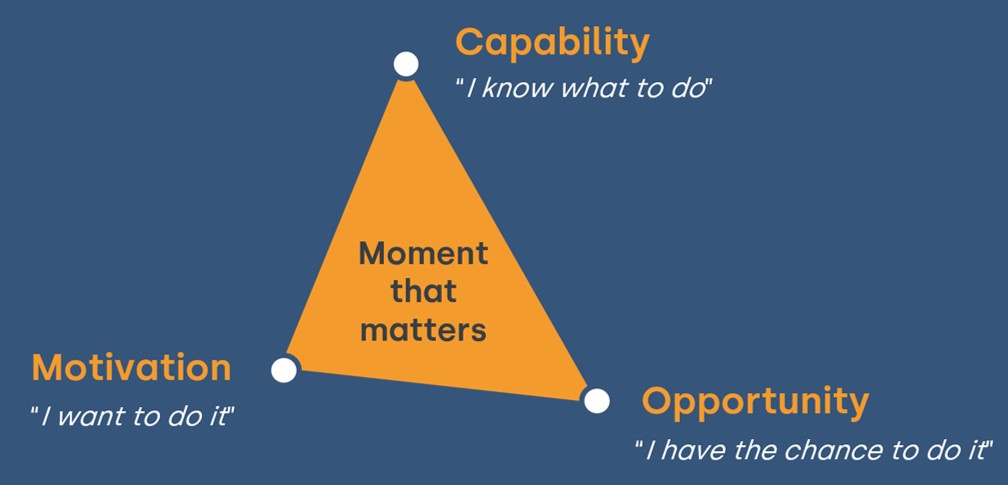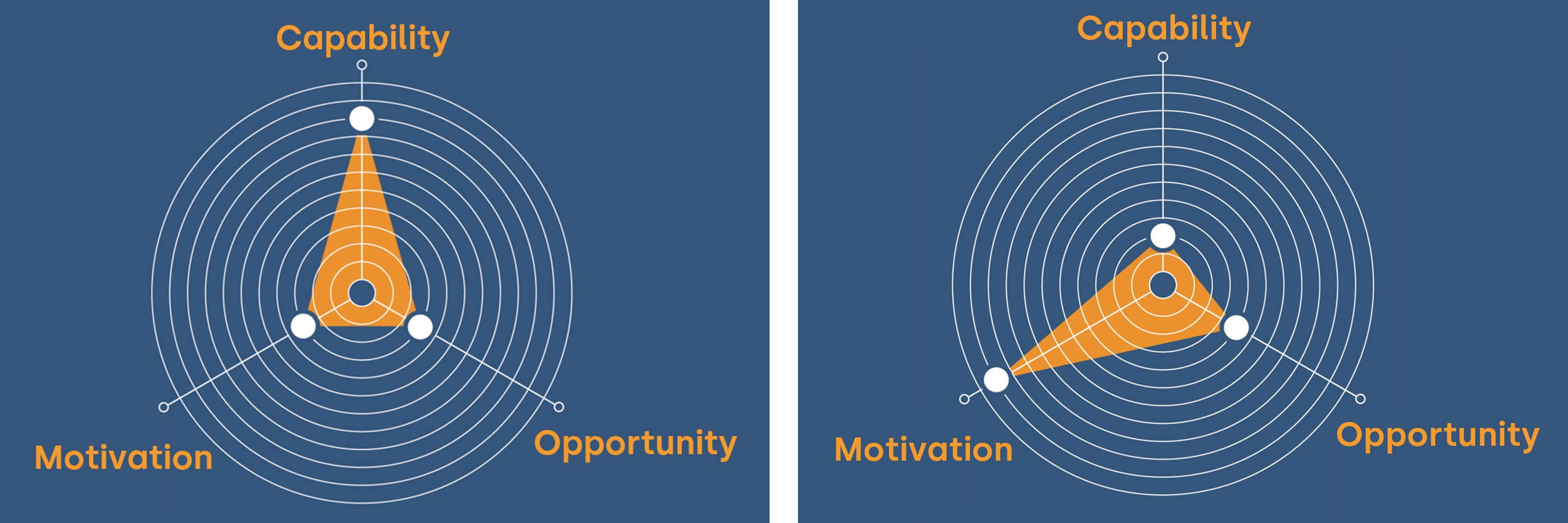Empathising with overloaded employees is critical for creating a positive response to learning and communication. Often this means that ‘less is more’ - giving people only what they actually need, at the right time, in an appealing and accessible way. But how can that best be done? Here are three strategies to help you.
Hands up if this sounds familiar… From when you first wake up in the morning, you’re surrounded by a stream of information. Maybe you listen to the radio in bed or in the shower. You skim through social media while you munch your brekkie, reply to a couple of Whatsapp messages, distractedly scan some websites, and check your gmail. Amongst these channels, you’ve been fed numerous ads, whether or not you’ve noticed them.
By 9am, you’ve been bombarded with noise, chatter, information, and a kaleidoscope of visual messaging. Your brain has attempted to filter what you need from what you don’t. All this even before you’ve thought about what you need to get done at work that day.
Perhaps your morning starts differently, but ‘information overload’ (a term coined as far back as the sixties [1], [2]) is a problem we all face daily. And it’s getting worse.
Combined with other stresses
Information overload is only one part of the picture.
Accelerated by the pandemic, employee well-being has rightly come into sharper focus of late. In the difficult months of Covid restrictions and home schooling, kudos was given to employers who showed care towards their people, while negative press dogged the big bosses who didn’t.
Forward-thinking employers are exploring options for better supporting employee wellbeing. A pilot four-day working week in the UK is one example, with around 30 companies trialling a six-month period in which employees will work 80% time with no loss in pay (though expected to deliver 100% of current productivity).[4]
Burn out is a real issue. Recent McKinsey research[5] found that nearly half of employees say they have symptoms of burn out at work. The same survey found that more than half of those surveyed would like to work from home for three or more days every week. And interestingly, employees reported higher levels of well-being and productivity when they feel their organisation has communicated clearly with them about expectations and future plans.
The future of employment is already starting to take a different shape, with hybrid working, well-being and good communication high on the agenda.
What does it mean for ‘learning’ at work?
So what are the implications for learning and communication at work?
It’s critical to start with empathy for the different pressures people are experiencing. This is a rallying cry for anyone thinking about how to engage employees. We need to think differently, not just roll out 20-minute e-learning modules as the unquestioning response to any need to shift behaviours at work.
OK, but what does ‘more for less’ learning look like? Is it possible to ask less of employees, while getting more from the time and resources we put in?
Yes! Here’s how…
1. Target your resources where they’ll make most difference
We can make a bigger difference if we focus our efforts on the outcome, by digging into what’s going to affect employees’ behaviour choices. And we do that by understanding what drives that behaviour.
There are three behavioural drivers we can use: capability, motivation and opportunity.
Let’s say you want to cook some healthy meals at home. What are the things that will make this easier for you to do?

Maybe you need to brush up your cookery a bit. Perhaps you need to figure out some meal plans, or gain a few culinary skills (best ways to chop veg, cooking perfect rice, making the whole thing taste nice?). To help you out, you could get a recipe book, ask a friend, check out some YouTube videos on that perfect rice.
So you’re working on your capability as a home cook.
Or maybe there’s a bit of a motivation challenge. You have good intentions to cook those healthy meals, but when it actually comes to it, you find it hard to motivate yourself. After a busy day, it feels much easier to reach for the ready-made pizza in the fridge than to get your pans out.
Or perhaps the main issue is that you’re blocked by your situation. You haven’t had a chance to shop for ingredients, or you need new knives. Or maybe you’re very short of time between work and other commitments. This is what we call an opportunity gap – you don’t have the chance to do the thing you’re trying to do.
At Acteon, we use these three behavioural drivers when we kick off a project with a client. We always start by unpicking the ‘moment that matters’. What is it that you need people to do? And then what will affect whether they will actually do it? What help do they need with capability, motivation and/or opportunity?

Every project will have a different emphasis - a different balance of these drivers. But, crucially, we help clients target resources where they will make the most difference to influence behaviours.

2. Reduce task-switching: Can you place ‘learning’ into the existing flow of work?
If we’re trying to achieve a particular outcome (from compliance to adopting a new system or approach), do we really need ‘learning’ in the traditional sense? Or do we need things like tools, information, job aids or nudges to provide information or reminders to people at just the right time? (It may be a combination.)
Tools and resources that help people when they need it are often more effective.
But we also need to make it easy for people to access these tools or to see those prompts. Let’s go to where people already are, rather than expecting them to come to a new platform.
‘Learning in the flow of work’ is a phrased coined by industry analyst Josh Bersin[6], who argues that a learning management system is rarely used for anything but compliance training. Instead, Bersin says:
“Learning in the flow of work… recognizes that for learning to really happen, it must fit around and align itself to working days and working lives. Rather than think of corporate learning as a destination, it’s now becoming something that comes to us.”
So how can we use existing channels - email, intranet, Teams, Slack, etc - to share ‘learning’ as helpful information that people can access when they need it? This helps to make it obvious and readily discoverable.
By using a campaign approach we can tap into a range of existing channels – perhaps both physical and digital – that people are already using, and where they’ll see our messages.
3. Reduce overload: What’s the minimum they need?
Back to that ‘information overload’ problem, starting from the moment you wake up… To get messages through to overloaded employees, we need to empathise with this problem of noise, and help them navigate information.
Have a top-level message for a campaign. Think TikTok, Twitter, bite size ways to make messages stick.
And then below the top-level message, provide the essential information stripped back to the minimum stuff they need to know. What’s the minimum amount of information that people need, to support them in adopting a way of working?
If you need detail or background, think about other ways to provide that, such as reference pages, glossaries, etc.
In fact, do people need new information at all? Or is there a more effective way to help them take the action you want? Maybe there are ‘opportunity’ gaps where the environment or systems need adjusting to support them.
A simple prompt or nudge could help them remember to do something. Our recent SmartCash campaign for Co-op used stickers on check out tills to help colleagues remember to use the new cash management system. They didn’t need extra information – they just needed a reminder.
Less overload, more impact
To sum up, let’s start with people rather than information. Empathising with people’s situations and thinking about the best ways to help them will help us communicate much more effectively. And in turn, we know that more supportive communication is positive for employee wellbeing.
By unpicking what happens when people take an action – in the ‘moment that matters’ – we can target resources to influence those three behavioural drivers of capability, motivation and opportunity.
Then we can think about how we can reduce friction, reduce overload and reduce task-switching. Keep things simple and make them easily discoverable.
The benefit of getting this right?... Happier people who are supported in their work.
- [1] Gross, B. (1964). The Managing of Organizations. Cambridge University Press. https://www.cambridge.org/core/journals/american-political-science-review/article/abs/managing-of-organizations-by-bertram-m-gross-new-york-the-free-press-of-glencoe-1964-2-vols-pp-xxviii-971-2500/0A126A109557A7DA2E3A7862C8C319AD
- [2] Toffler, A. (1970). Future Shock. Random House. https://en.wikipedia.org/wiki/Future_Shock
- [3] Information Overload Research Group https://iorgforum.org/io-basics
- [4] https://www.4dayweek.com/ukpilot
- [5] McKinsey & Company report, (2021). “What employees are saying about the future of remote work”. https://www.mckinsey.com/business-functions/people-and-organizational-performance/our-insights/what-employees-are-saying-about-the-future-of-remote-work
- [6] Bersin, J. and Zao-Sanders, M., Making Learning a Part of Everyday Work, Harvard Business Review, February 2019. https://hbr.org/2019/02/making-learning-a-part-of-everyday-work
